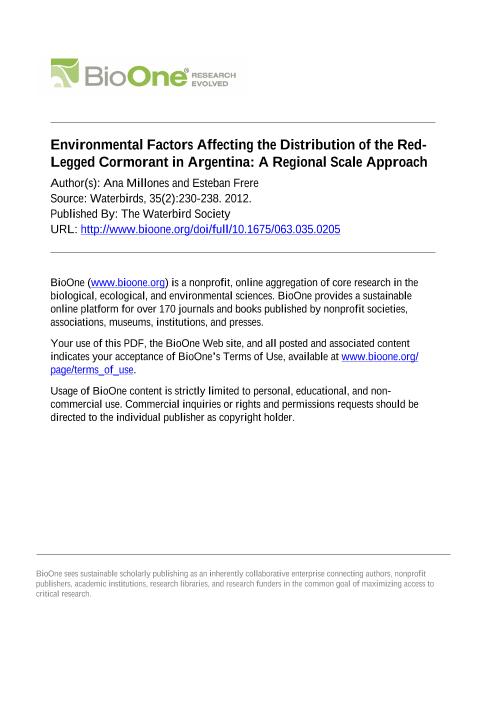Mostrar el registro sencillo del ítem
dc.contributor.author
Millones, Ana

dc.contributor.author
Frere, Esteban

dc.date.available
2023-05-02T11:03:47Z
dc.date.issued
2012-06
dc.identifier.citation
Millones, Ana; Frere, Esteban; Environmental Factors Affecting the Distribution of the Red- Legged Cormorant in Argentina: A Regional Scale Approach; Waterbird Society; Waterbirds; 35; 2; 6-2012; 230-238
dc.identifier.issn
1524-4695
dc.identifier.uri
http://hdl.handle.net/11336/195905
dc.description.abstract
Red-legged Cormorants (Phalacrocorax gaimardi) breed along a broad stretch of the Pacific coast and a section of the Argentinian coast on the Atlantic Ocean. To understand factors that might determine the breeding range along Argentina, physical and environmental characteristics of cliffed coastlines used by Red-legged Cormorants were compared with those not used. Red-legged Cormorant colonies were found in longer cliffed coastlines (mostly longer than 250 m) with shallow waters (median depth =12 m) and high sea productivity close to the coast (median chlorophyll a concentration = 4.4 mg/m3). Within the Red-legged Cormorants' breeding range the probability of occurrence of their colonies increased with the length of the cliffed coastline and decreased with the median sea depth around the colony. Mixed colonies were found in coastal areas with cliffs where the seawater close to shore was deeper (deeper than = 13 m). North of its distribution, sea productivity close to the coast was lower (median chlorophyll a concentration = 1.6 mg/m3) than within its distribution, and cliff faces were more exposed to the strong prevailing winds, which can blow eggs and chicks from their nests. South of its distribution, the climatic characteristics were more adverse to breeding success: higher precipitation, lower ambient temperature, and higher wind speed than within its distribution. At this scale of study (regional), new aspects of habitat structure of the Red-legged Cormorant, such as sea primary production, water depths and climatic features, were indentified. All these aspects could be affecting habitat selections by this species.
dc.format
application/pdf
dc.language.iso
eng
dc.publisher
Waterbird Society

dc.rights
info:eu-repo/semantics/openAccess
dc.rights.uri
https://creativecommons.org/licenses/by-nc-sa/2.5/ar/
dc.subject
ARGENTINA
dc.subject
BREEDING RANGE
dc.subject
ENVIRONMENTAL CONDITIONS
dc.subject
PHALACROCORAX GAIMARDI
dc.subject
RED-LEGGED CORMORANT
dc.subject.classification
Zoología, Ornitología, Entomología, Etología

dc.subject.classification
Ciencias Biológicas

dc.subject.classification
CIENCIAS NATURALES Y EXACTAS

dc.title
Environmental Factors Affecting the Distribution of the Red- Legged Cormorant in Argentina: A Regional Scale Approach
dc.type
info:eu-repo/semantics/article
dc.type
info:ar-repo/semantics/artículo
dc.type
info:eu-repo/semantics/publishedVersion
dc.date.updated
2023-04-26T16:47:11Z
dc.journal.volume
35
dc.journal.number
2
dc.journal.pagination
230-238
dc.journal.pais
Estados Unidos

dc.description.fil
Fil: Millones, Ana. Universidad Nacional de la Patagonia Austral. Unidad Académica Caleta Olivia. Centro de Investigaciones Puerto Deseado; Argentina
dc.description.fil
Fil: Frere, Esteban. Universidad Nacional de la Patagonia Austral. Unidad Académica Caleta Olivia. Centro de Investigaciones Puerto Deseado; Argentina. Consejo Nacional de Investigaciones Científicas y Técnicas; Argentina
dc.journal.title
Waterbirds

dc.relation.alternativeid
info:eu-repo/semantics/altIdentifier/doi/http://dx.doi.org/10.1675/063.035.0205
Archivos asociados
